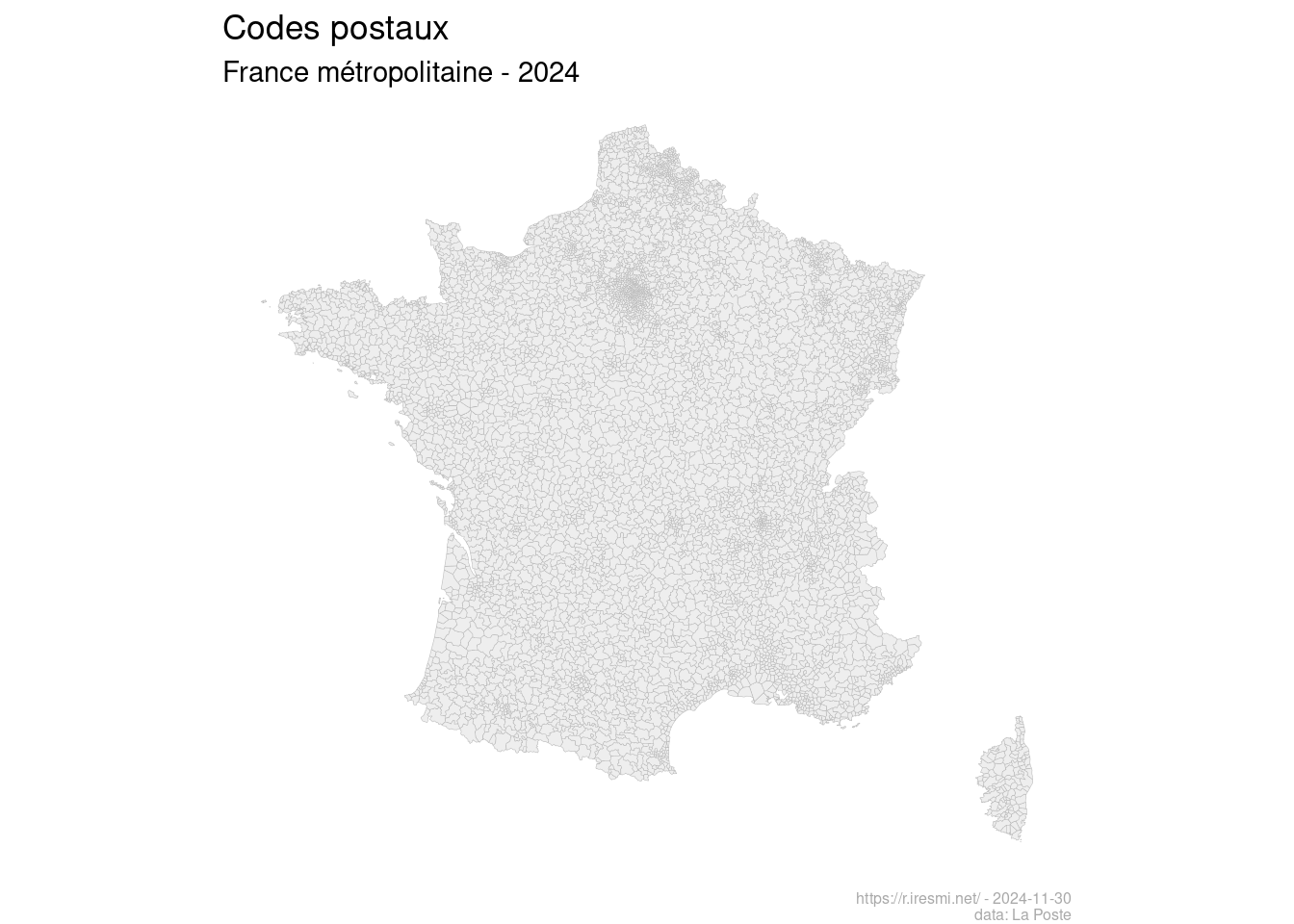library(readr)
library(dplyr)
library(tidyr)
library(stringr)
library(purrr)
library(ggplot2)
library(glue)
library(janitor)
library(sf)Day 30 of 30DayMapChallenge: « The final map » (previously).
Creating a raw polygon layer of french postal codes from points
This data, although not a “real” administrative limit, is often used in many different applications, see for example the BNV-D.
There is no free, up-to-date, layer of polygon boundaries for french postal codes.
The official database is just a table giving a postal code for each commune code, optionally with point coordinates. We have some postal codes shared by several communes and some communes have several postal codes (at the same point location).
Update 2025A CSV file is now available with JSON encoded geometry.
Using the national address base (BAN) we can compute the convex hulls: Contours calculés des zones codes postaux. Interesting method but old (2021) and with many holes/overlaps
Fond de carte des codes postaux is nice (although métropole only) but old (2013).
Config
Data
# Postal codes as point by commune
cp_points <- read_csv("https://datanova.laposte.fr/data-fair/api/v1/datasets/laposte-hexasmal/metadata-attachments/base-officielle-codes-postaux.csv",
name_repair = make_clean_names) |>
separate(geopoint, into = c("lat", "lon"), sep = ",", convert = TRUE) |>
drop_na(lon, lat) |>
st_as_sf(coords = c("lon", "lat"), crs = "EPSG:4326") |>
filter(str_sub(code_commune_insee, 1, 3) < "987") |>
mutate(proj = case_when(str_sub(code_commune_insee, 1, 3) %in% c("971", "972", "977", "978") ~ "EPSG:5490",
str_sub(code_commune_insee, 1, 3) == "973" ~ "EPSG:2972",
str_sub(code_commune_insee, 1, 3) == "974" ~ "EPSG:2975",
str_sub(code_commune_insee, 1, 3) == "976" ~ "EPSG:4471",
.default = "EPSG:2154"))The low quality of the positioning in the original dataset will give bad results: e.g. some points are clearly in the sea (Cayenne, Cannes, Le Conquet,…). So a manual correction should be done.
# France limits, to clip voronoi polygons
fr <- read_sf("https://static.data.gouv.fr/resources/admin-express-cog-simplifiee-2024-metropole-drom-saint-martin-saint-barthelemy/20240930-094021/adminexpress-cog-simpl-000-2024.gpkg",
layer = "departement") |>
mutate(terr = if_else(insee_reg > "06", "fx", insee_reg)) |>
group_by(terr) |>
summarise()
# Communes limits and population to give the name of the postal code as the
# biggest commune (by pop)
com <- read_sf("https://static.data.gouv.fr/resources/admin-express-cog-simplifiee-2024-metropole-drom-saint-martin-saint-barthelemy/20240930-094021/adminexpress-cog-simpl-000-2024.gpkg",
layer = "commune")Processing
We will create voronoï polygons from grouped postal codes points. That will give a very simplified geometry. For a more detailed geometry see below.
st_rename_geom <- function(x, name) {
names(x)[names(x) == attr(x, "sf_column")] <- name
st_geometry(x) <- name
return(x)
}
# We need to use a projection for each territory to avoid geometry errors
voronoi <- function(df, k) {
df_proj <- df |>
st_transform(pull(k, proj))
df_proj |>
st_union() |>
st_voronoi() |>
st_cast() |>
st_intersection(st_transform(fr, pull(k, proj))) |>
st_sf() |>
st_rename_geom("geom") |>
st_join(df_proj) |>
group_by(code_postal) |>
summarise() |>
st_transform("EPSG:4326")
}
# get the names of the main town of each postal code
noms <- cp_points |>
st_join(com |>
select(insee_com, nom, population)) |>
group_by(code_postal) |>
slice_max(population, n = 1, with_ties = FALSE) |>
select(code_postal, nom) |>
st_drop_geometry()
# create the voronoï for each territory
cp_poly <- cp_points |>
group_by(proj) |>
group_modify(voronoi) |>
ungroup() |>
select(-proj) |>
st_sf() |>
left_join(noms, join_by(code_postal))Map
An extract only on métropole:
cp_poly |>
filter(str_sub(code_postal, 1, 2) < "97") |>
st_transform("EPSG:2154") |>
ggplot() +
geom_sf(fill = "#eeeeee",
color = "#bbbbbb",
linewidth = .1) +
labs(title = "Codes postaux",
subtitle = "France métropolitaine - 2025",
caption = glue("https://r.iresmi.net/ - {Sys.Date()}
data: La Poste")) +
theme_void() +
theme(plot.caption = element_text(size = 6, color = "darkgrey"))
Export
Full dataset.
cp_poly |>
st_write("codes_postaux_fr_2025.gpkg",
delete_layer = TRUE,
quiet = TRUE,
layer_options = c("IDENTIFIER=Codes postaux France 2025",
glue("DESCRIPTION=Métropole + DROM WGS84.
d'après données La Poste + IGN Adminexpress
https://r.iresmi.net/ - {Sys.Date()}")))Get the files:
- polygones des codes postaux français 2024 (geopackage WGS84) (3 MB).
- polygones des codes postaux français 2025 (geopackage WGS84) (3 MB).
- Métropole + DROM (no Polynesia, New Caledonia,…)
- Some polygons parts (505) cover other polygons in communes where several postal codes are present.
- 4 NAs (multipolygons without postal codes) are present covering territories outside the voronoï polygons.
- No postal code for St-Barth/St-Martin?
Convert the new CSV/geoJSON file
That’s a funny file format (geoJSON in a CSV)!
The geometry is very detailed (too much?)
library(dplyr)
library(readr)
library(httr2)
library(janitor)
library(glue)
library(sf)
library(purrr)
library(geojsonsf)
library(lubridate)
cp_file <- "019HexaSmal-full.csv"
if (!file.exists(cp_file)) {
request(glue("https://datanova.laposte.fr/data-fair/api/v1/datasets/laposte-hexasmal/data-files/{cp_file}")) |>
req_perform(cp_file)
}
cp_geo <- read_csv(cp_file,
name_repair = make_clean_names) |>
mutate(geometry = st_sfc(map(contours_commune_geometry,
possibly(\(x) st_geometry(geojson_sfc(x))[[1]],
otherwise = st_multipolygon()))),
.keep = "unused") |>
st_sf(crs = "EPSG:4326") |>
st_make_valid() |>
write_sf(glue("codes_postaux_fr_{year(now())}_v2.gpkg"),
layer_options = c(glue("IDENTIFIER=Codes postaux France {year(now())}"),
glue("DESCRIPTION=Métropole + DROM + COM WGS84.
d'après données La Poste {cp_file}
https://r.iresmi.net/ - {Sys.Date()}")))